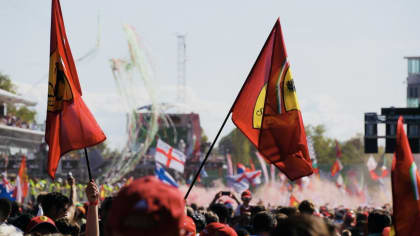SCREEN-PRINTING IS NOT FOR THE WEAK
The Making of a Screened Shirt and
Picking our Favorite Automotive T-Shirts
This article is from our archives and has not been updated and integrated with our "new" site yet... Even so, it's still awesome - so keep reading!
Published on Tue, Dec 12, 2017
By: The LACar Editorial Staff

By Tom Gomez
When you say “screen-printing” the first thing that comes to mind is some dude in a backroom feverishly scraping a screen and has ink smeared everywhere, sweating with a look of panic. Well, part of that is true, except for that one guy.
In today’s world the days of one or two guys or gals making screens and printing T-shirts are almost gone. If you want to stay competitive, you have to operate like a NASCAR or NHRA pit crew—it’s team effort here folks.
Let’s first talk about how the t-shirt even came about.
The first T-shirt appeared in the Spanish-American war, when the U.S. Navy made them as standard issue to new recruits. Soon, it was adopted by the Army to be worn under their uniforms—they came in a crew neck with short sleeves. It got its iconic name because of the shape resembles the letter “T”. The inexpensive cotton was easy to clean and became the shirt of choice by mothers for their sons to play and do chores. By the 1920s, “T-Shirt” became an official American-English word in the Merriam-Webster’s Dictionary.
The earliest printed shirts that we know of are the shirts from the 1939 movie, “The Wizard of Oz”. Some were used as promotional items, and only a limited amount were made.
Credit to the first published photo of a printed t-shirt is that of an air gunnery school t-shirt featured on the July 13th 1942 cover of LIFE magazine. Mickey Mouse would soon follow years later.
So, we wanted to investigate this ancient form of t-shirtness and get to the skinny of how the images get printed.
While in the Charlotte North Carolina area, we decided to stop at one of the top screen printers in the Carolina’s to get the down and dirty on printing automotive t-shirts. Toby Peltier is the owner of a shop called “The Shirt Lizard”. He’s a car dude, so making screen-printed automotive t-shirts makes for a good combo.
We asked Toby what the heck is a shirt lizard? He replied, “It’s just a name, and it sounded catchy.” Was it possibly a distant cousin of the Geico gecko? Okay, maybe we stretched that theory a bit.
In the many years of writing automotive tech articles, we've always asked questions of “how does that work?” Or, we actually did the install ourselves. So, how hard can it be to make a t-shirt?

First, you need “Artwork”.
We asked Mr. Peltier what is the biggest problem in making a t-shirt? “Communication”, he says. In order to get a good “print”, you need good artwork. How many colors and what kind of material is the shirt to be printed on? Screen printers prefer a vector file or a EPS file. EPS, stands for Encapsulated Postscript. An EPS file can contain text as well as graphics. Then, we find out there’s another preferred file called a “raster”.
Whew! We’re confused; are you? To better educate you folks on something you may or may not care to know about, we are going to include a graph to help you understand the different files so you can talk like an expert to your local t-shirt guy.
OMG, we haven’t even got out of the graphics office yet. When can we start making shirts, darn it!
Mr. Peltier smiled and says “okay, you asked for it”. Haha we laugh. You’re talking to seasoned gearheads who have skinned knuckles, drink energy drinks like water , and build engines that go fast. How hard could this be? Carry on wayward son!
The next step is take the artwork to be scanned in a computerized system that reads the file and exposes it on a screen. The process is similar to camera film being exposed to produce an image. Once scanned, it’s off to the main shop area where the t-shirts will actually be printed.

We walk into the abyss of machinery that looks like Doc Ock from the Spiderman movie and we think, “okay, maybe this isn’t going to be a quick process.”
Screens are loaded on a multi-arm carousel that can produce numerous shirts at a time. We must point out that for every color on a shirt there is a screen for that one color. So for example if there are six colors in the design, then there are six screens.
Each screen is then loaded with the required color of “ink” and loads of ink is then spooned onto the screen to be squeegeed onto the shirt. Sounds like some kind of mid-evil torture.
Oh yeah, we must also mentioned there isn’t any air conditioning in this place either. We don’t know if you’ve ever been in the South during the summertime, but for us California natives, it was like having a near death experience. Humidity took us down like a fixed wrestling match.
Most screen print shops big or small can produce one shirt or dozens, depending on the order. We asked Mr Peltier what is the most shirts he has printed for one order. His answer: 27,000. What? We couldn't believe it. “27,000”, he repeated with a sigh. It took a day-and-a-half of non-stop printing—hence, the title of the story: screen-printing is not for the weak.
The screen carousel is computer operated as well. The operator selects the speed of the turnstile and there is a machine that flash heats the shirts to aid in the drying and securing that the ink won’t smear as it goes through multiple screens. The operator can also regulate how hot the flash unit flashes each shirt. So if you’re not careful, you could burn a shirt before it get’s printed—ah, the smell of burning shirt ink in the morning!

We then do a test shirt, which is actually an old t-shirt that we can throw away if it doesn’t look right. The test print consists of checking the quality of the printing, color correctness to the original design and amount of pressure the ink is applied. Once all of those things are satisfactory, the real printing process starts. It takes two people to operate this tilt-o-whirl of screen-printing frenzy. The senior operator dials everything in and loads the shirt on a metal platform attached to one of the many arms of this mechanical monster and hits the GO button—and the madness starts.
The shirts go through the many screens absorbing the gobs of ink that is pushed through the specific screened artwork, as it comes full circle all of the colors have been applied and has been flashed dried at least two times. The second operator lies in wait as the finished shirt is ready to be removed from the metal platform. The operator then removes the shirt and carefully lays it on the conveyor belt to this humongous dryer that does the final drying of the ink printed image. At the end of this dryer, the shirts come out and one or two employees depending on the amount pick up the heated shirts off the metal conveyor belt.
We noticed that one of the employees was wearing protective gloves to remove the shirts off the conveyor belt. Gloves? We don’t need no stinkin’ gloves! So we tried it without gloves, because we are men, not just any men, but we are car dudes and we like heat! Wrong, it took one extremely hot shirt, that we immediately threw on the floor to realize that this is not a time to be macho! These freakin’ shirts are hot!
Okay, enough of that job. Let’s go put the shirts on the metal platform to be printed. How hard could that be?
Remember, these are on a timer and you only have seconds to put the shirt on correctly so the design will be correct on the shirt. Our first shirt went fairly smooth, as was the second, then the third came quicker and the fourth and, you get the idea. You guessed it—we fell behind and the operator had to stop the turnstile. Hmmm? Okay, so that was a little too much responsibility, let’s try the taking the shirts off the platform and loading onto the conveyor belt how hard could that be?
No one told us that the shirts are like super-glued to the metal platform, because the platforms are sprayed with a sticky light adhesive to prevent the shirt from moving and the twice-flash process keeps it firmly on the metal platform. So this requires you to have a firm gripped lift-and-pull technique that gets the shirt off the metal platform in seconds, before the next shirt comes around.
Have any of you seen the episode of the 1952 TV series “I Love Lucy” where Lucy’s at a candy factory? The candy is coming at her so fast on a conveyor belt, she can’t load them in a box fast enough—so she starts shoving the candies in her mouth while others are hitting the floor? Yeah, that was us, except we weren’t eating candies.
We had about 300 shirts to print for JDR Racing which is Jeff Diehl’s Top Fuel Funny car team out of Monterey California and so as to not ruin the precious shirt order we opted to take photos of the process instead of sweating all over the new shirts or catching them on fire.

Finally, the shirts were done and there was a sigh of relieve as they were being packed to be shipped-out that night. Mr. Peltier asked us if we wanted the whole screen-printing process experience. We looked in wonderment and confusion as we thought the hot sweaty process was over. No?
He took us over to a power washer and a “wash out” area that was used to clean the ink off of the screens. Power washers, yeah, now we’re talking! We’re down for some power washing. We’re car dudes, and we can power wash anything!
Wrong again, little camper. All of the screens that were used for that day and the day before needed cleaning, and man are they nasty. So we donned a rubber apron, rubber gloves, protective eye gear and proceeded to power wash the nasty ink laden screens. Have you ever tried to wash stinky sludge out of the parts cleaner sink in a garage or shop? Well that’s what it’s like, except it’s like 52 sinks worth of slimy ink-covered screens. Oh joy!
Once the screens were washed, dried and put away and ready for the next round of shirts to print, we noticed that our brand new Dickie shorts, Black t-shirt, Black socks were spackled with multi colors of ink. So sad.
But with a small squirt of some acetone and dried with compressed air, the material was as good as new! Yay!
So there you have it folks: The behind-the-scenes scoop of screen printing t-shirts in all its inky glory!
The moral of this story is, one, never take anything for granted, and, two, if you want to know what hard work is like, don’t dig a ditch, instead go screen print 300 shirts in 100 degree heat next to a giant dryer that operates at a steady 375-400 degrees and be a machine with the stamina of a mountain goat.
Whew! That wore us out just talking about it.
Seriously, we had a good time and the whole Shirt Lizard crew was very friendly and helpful. They were amazed we lasted as long as we did. They operated like a NHRA/NASCAR pit crew trying to win the checkered flag!
The fun part of this article is that all the editors at LACAR,COM get to pick their favorite t-shirt and showcase it here for you great fans to check out.

Our favorite shirt is number No. 300! For more information about The Shirt Lizard, go to shirtlizard.com. OUR FAVORITE AUTOMOTIVE T-SHIRTS:




